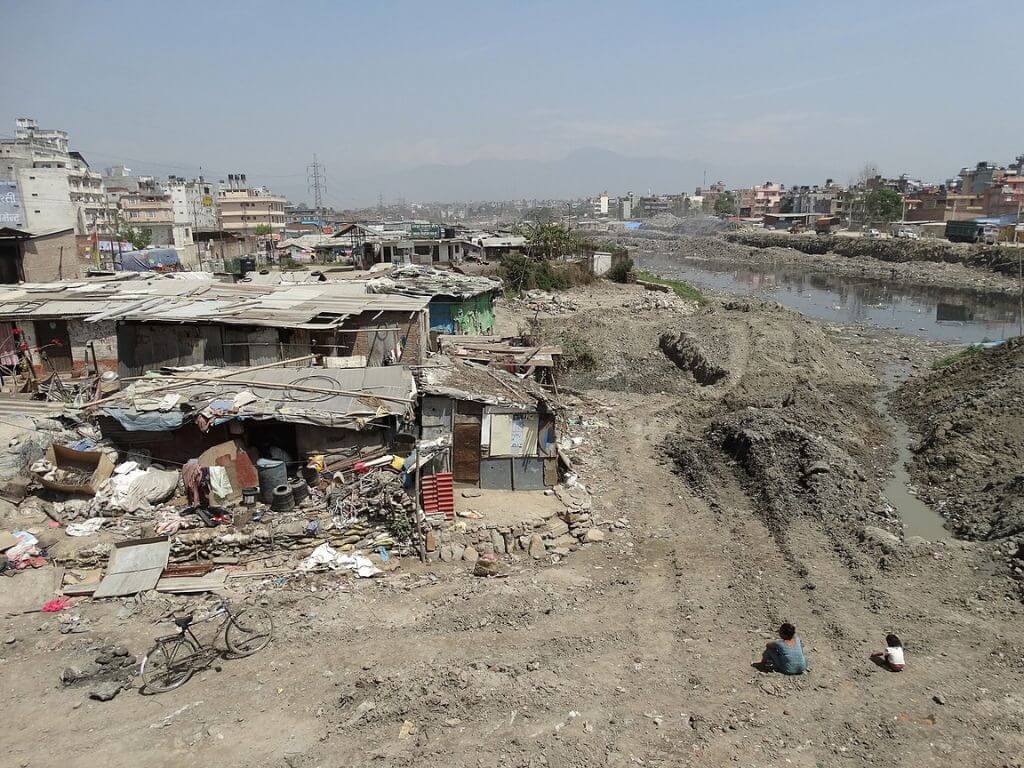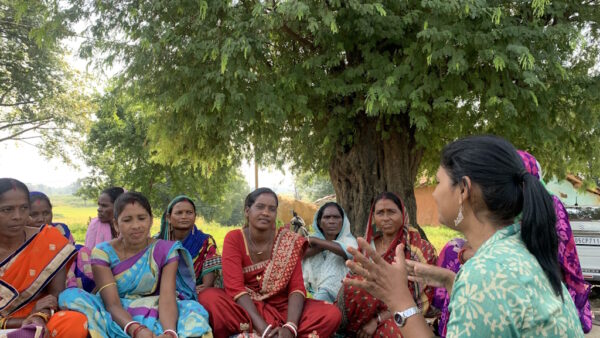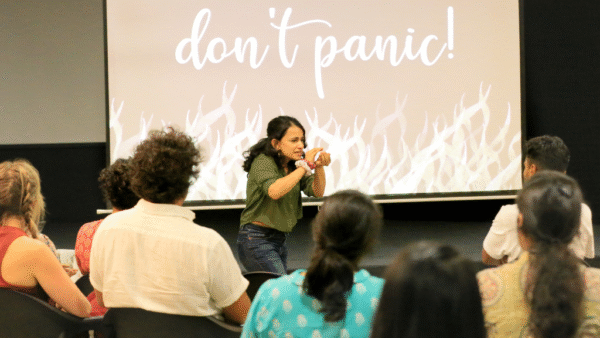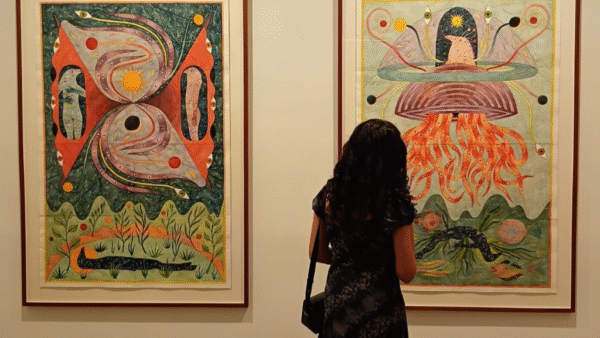“Last year was very unfortunate. My husband died just a few weeks after suffering from dengue. I don’t remember him being ill more than twice in all the years that we were married but it was lethal this time. If we had money to afford better healthcare, I think this tragedy could have been avoided.”
Pabitra Nepali, 54, breaks down when speaking of her husband. They both used to work as construction labourers. She continues to live in ward 13, a squatter settlement, of the Bagmati corridor. Her health is failing too and she is supported by her elder son who works in Dubai. She is worried about the future of her younger son who is neither educated nor working for his living.
Nepali’s life could be that of a woman or man living in any of the squatter settlements in Kathmandu and other cities of Nepal. While the settlements do not show homogeneity, they have common characteristics. Most squatters living in Kathmandu’s settlements are migrants from different parts of the country and lack legal tenure to the place they occupy. Sukumbasi, a Nepali term for squatter denotes an individual without shelter and private land for cultivation, a general lack of access to earn a livelihood. Life in squatter settlements is further tested by frequent climate events. These settlements, like in the rest of the developing world, are projected to rise.
The International Panel on Climate Change (IPCC) Sixth Assessment Report[1] states that vulnerabilities of urban informal settlers will continue to increase and the only way to get rid of this problem is by prioritising the alleviation of their various risks, particularly for the marginalised and poor residents of these informal or squatter settlements.
Realising the gravity of the issue, the Sustainable Development Goals have also incorporated the issue of squatter settlements. Goal 11[2] is concerned with the development of inclusive, safe, resilient and sustainable cities. Similarly, the New Urban Agenda[3] incorporates the issues of upgrading informal settlements and preventing such settlements by providing decent jobs, infrastructure services and affordable housing to the entire population. What they mean in the context of Nepal is the key question.
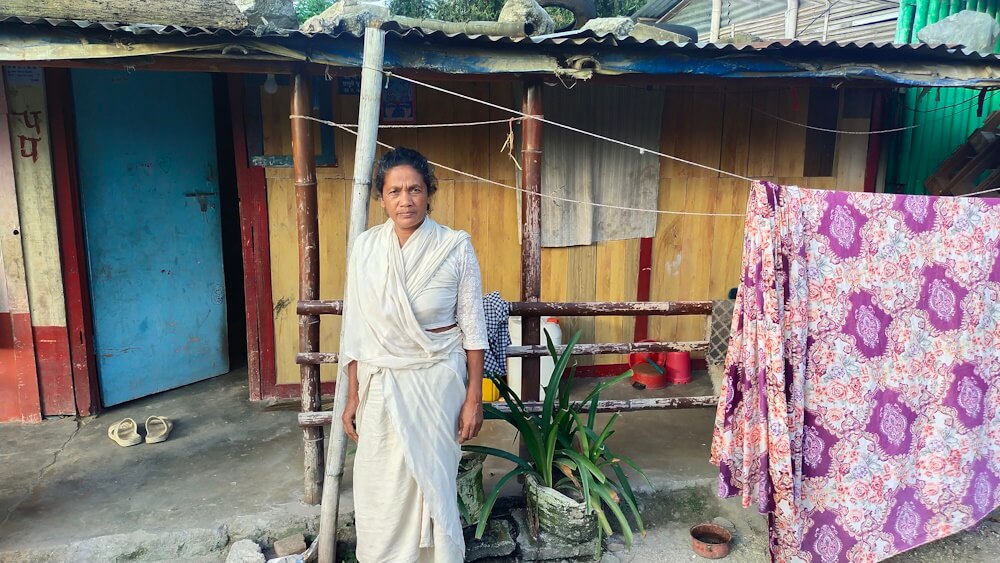
Photo: Chhatra Karki
Nepalese context
Squatter settlements in Kathmandu continue to increase with the growing trend of rural-urban migration in search of better opportunities of education and employment. While there were only 17 squatter settlements in the valley in 1985, this grew four-fold by 2022, as a research[4] shows.[5] Most squatter settlements are located along the five rivers of the Kathmandu Valley – Bagmati, Bishnumati, Hanumanthe, Tukucha and Dhobikhola.
Nepal contributes only 0.025 percent of the total global emission, but is severely affected by climate change.[6] With the growing impact of climate change, the vulnerabilities of squatter settlements continue to aggravate as the coping capacities of such settlements are limited. These settlements have hardly any access to basic services. Furthermore, increasing incidence of climate-induced disasters like floods continues to exacerbate their woes. Factors like low literacy rate, poor infrastructure, financial constraints and lack of social networks and institutions continue to worsen their woes. Piling up sandbags to protect themselves from the rising level of the river has become a heart-rending scene in these settlements.
Living under pathetic conditions in houses with corrugated iron sheets – sometimes even plastic tarpaulins held down by stones – these dwellings have walls of poor-quality bricks. People living in them have access to electricity and television but water supply, sanitation and waste management are still matters of concern. In a study led by R.K. Phuyal in 2019, which assessed water quality in 37 squatters and five indigenous communities’ settlements, as high as 90 percent of the domestic water was found to be contaminated biologically and chemically.
In the urban areas of Kathmandu, such settlements are viewed negatively. The squatters are accused of creating additional economic and environmental pressures. They are tagged as ‘outsiders’ or ‘invaders’ or ‘river polluters’ but also, curiously, as ‘clientele’ who can be summoned any time to participate in political demonstrations and rallies.
Squatters’ plight on the ground
Jhabar Urau Suman, 48, has been living in Pragatibasti since 2006. Originally from Sunsari, a village in eastern Nepal, he came to Kathmandu in search of employment opportunities way back in 1987. He lives with his wife and three grown-up children. “I participated in a mass cycle rally of squatters in 2006. During that protest, I came to know about an open public space available near the Bagmati corridor and decided to settle here,” he explained how he came to settle here.
Though he has years of experience in construction, painting, contracting land and weaving, Suman has been jobless as work opportunities declined particularly after the economic slowdown in the country in the aftermath of the COVID-19 pandemic. His wife sells chatpate, a tangy food popular among the youth, on the streets to earn a few rupees. His son, who is in Dubai, also sends money to run his family. While his elder daughter is pursuing undergraduate studies, his younger daughter is studying for a diploma in pharmacy.
The squatter settlement that he lives in has 143 households. While there is no water supply from the government, there is electricity access through a dedicated feeder line. Yet, the community has to depend on water fetched from nearby taps. Children have access to public education and schools in the vicinity have offered scholarships.
Nevertheless, the squatters live amid fear and uncertainty, particularly the fear of eviction and shelter demolition, given the many times the government has attempted to demolish the settlements. This hostile environment increases the stress on young children and impacts their studies. Riya Napit, a Class 10 student, said: “Last year, when I was preparing for my pre-board exam, the demolition drive began. I was petrified by this move and couldn’t focus on my studies. As a result, I couldn’t get good marks. We are always fearful. Aren’t we also human beings? If we had enough money, we would buy a house and settle in a better place.”
Gopal Paudel, 36, could not continue his college education though he wanted to study. To earn money and fulfill financial obligations towards his family, he lived and worked in Dubai for eight years. Now, he runs a small shop in Paurakhi Basti. Reiterating that squatters have no choice but to live on open public land, Paudel expressed his utter dismay at the attitude of the authorities towards squatter settlements.
“The government doesn’t recognise that we have also helped in conserving public land from further degradation. Instead, we are always viewed as invaders and humiliated in social and public spheres. Political parties also use us as a weapon or treat us as their vote banks,” explained Paudel, “An independent candidate came to us during a local election promising that he would settle the issue, and he got votes. But after becoming the mayor of Kathmandu, he turned a deaf ear to our plight. Instead, his office wanted to demolish our settlements in November last year. This is a worrying situation.”
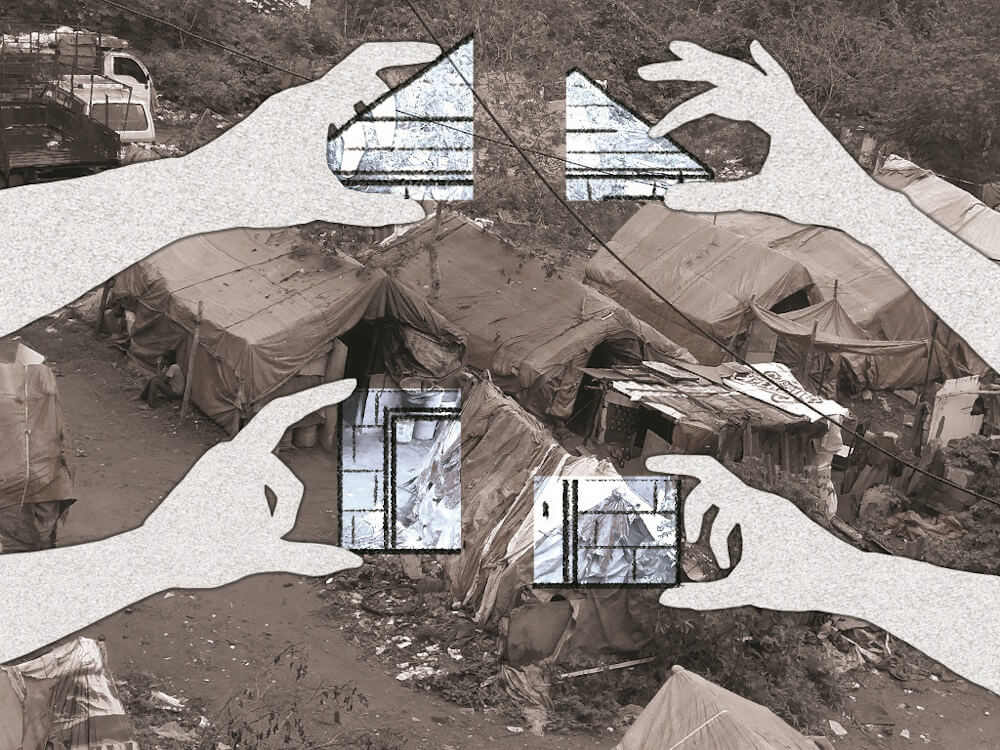
Illustration: Shivani Dave
Multiple institutions and blame game
The day-to-day suffering of squatters continues in the absence of a thought-out and coherent policy on informal settlements. Successive governments, which should have provided shelter, have made several attempts to demolish slums. One of the most controversial demolition drives was in May 2012[7] when the then Baburam Bhattarai government mobilised nearly a thousand personnel from the Armed Police Force. More than 250 squatter huts were demolished leaving 1,000 people homeless, including 400 children. This elicited wide criticism from civil society organisations and human rights groups, but the people continued to suffer.
Ironically, the government tried to provide housing to those who lost their shelter in the demolition at the Ichangu Narayan Housing Project for Squatters and the Urban Poor at a cost of over Rs 110 million. However, the squatters refused[8] to occupy the newly-constructed building because it had narrow rooms and demanded a hefty rent which was not convenient or affordable for them.
Although the government claimed that the new building would suit the squatters, they had several reservations about the place. One of the issues was that the small housing units could not accommodate their families and the cost was too high for such a small space. There’s another significant aspect to this so-called rehabilitation. The local residents of Ichangu resisted the rehabilitation and vowed not to allow squatters to reside in their community. The demeaning attitude towards slum dwellers was not new, but exposed, once again, the dominant socio-cultural perspective of slum dwellers.
“We were sidelined during the planning and discussions, and were called for consultations only after it was built,” said Krishna Paudel, a member of the Society for the Preservation of Shelters and Habitations in Nepal, a network of landless people in the country. “We refused to move there because we feel betrayed. We see the government trying to get rid of us, moving us far away to live in cramped spaces like cattle. Just because we are landless, the government cannot treat us inhumanely,” he lamented.
In November 2022,[9] the Kathmandu authorities made another attempt to clear squatter settlements on the bank of the Bagmati river. The incident resulted in a clash between the police and the squatters. The latter refused to move and resisted the forced evacuation on the grounds that it was against the fundamental right to life and property. They demanded alternative living spaces.
These events show the dichotomy in the government approach to squatter settlements – on one hand, the government makes an all-out attempt to evict squatters and clear land while, on the other, it offers rehabilitation to a few of them but of a kind that they cannot afford or use. This is made worse by the engagement of multiple institutions at the federal and local levels; the multiplicity of agencies has led to major policy dilemmas on squatter settlements.
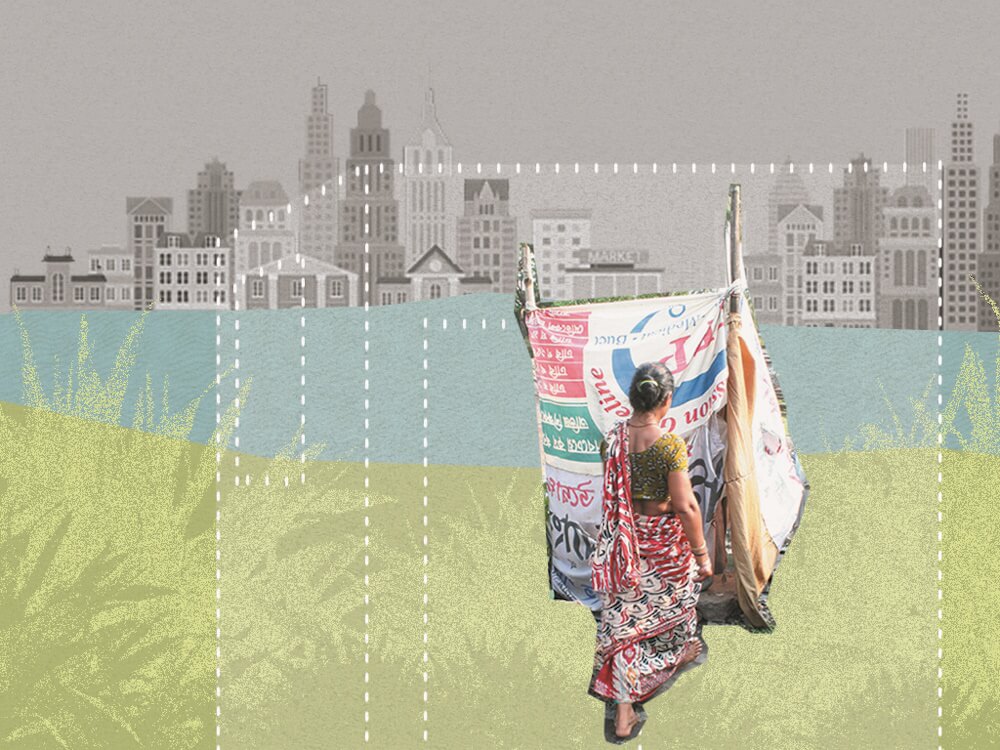
Illustration: Shivani Dave
With an objective of identifying the total number of squatters in the country, the Government of Nepal formed the National Land Commission in 2021. While this provides a broad framework, it entrusts the local government to maintain records which can identify or verify the squatters, and distribute land certificates. The multiplicity of agencies allows each to pass the buck and play the blame game. The Kathmandu Metropolitan City (KMC), which should have shouldered more responsibility, appears to shirk it.
“We have been trying to settle this issue in a more rational and sustainable way. But there is no cooperation from other state agencies and civil society organisations working in this sector. This is a worrying scenario. Finding a long-term solution to this issue remains almost impossible without firm commitment of the state’s leadership,” says a senior KMC official, requesting anonymity.
Bhagwati Adhikari, an activist relentlessly working for squatters’ rights, said: “While other municipalities like Dharan and Lalitpur have expedited the process of record maintenance, and other local governments have distributed land certificates to landless Dalits, the KMC continues to neglect its duties. In fact, it has violated its agreement inked with the Kathmandu District Committee (KDC) of the National Land Commission to begin the process of identification and verification of squatters to settle the issue.”
The blame game continues to cause distress to the informal settlers. Uddhab Timsina, president of the high-powered Committee for the Integrated Development for Bagmati Civilization, another federal institution mandated to beautify the banks of Bagmati River, said, “Although the KDC of the National Land Commission has asked KMC to collect the records of the people living in the squatter settlements, it has not shown interest. We have had to meet the Prime Minister to request the necessary support. Most of the squatters are not the real landless, they have been doing businesses elsewhere and own property. Hence, the government is not serious about this.”
Way forward
The impasse has to be broken. Most of the squatters interviewed for this report said that the KMC, being the local government, should identify and verify the squatters on the lines laid down in the National Land Commission.
“Asking people to fill up the form with vital details of their property, income and other assets will help identify the squatters. But the state also needs to give options for rehabilitation from which squatters can choose. It can work out a policy of renting out flats to squatters charging a minimum fee and providing them income-generating opportunities to earn their living. Only the real destitute and helpless people might remain here,” said Ganesh Paudel, 36.
The current resettlement plan, flawed as it is, has to bite the dust. It is imperative that a practical resettlement plan has to be worked out – and implemented – with adequate stakeholder consultations with representatives of the squatters and slum dwellers, local and federal governments, and the ensemble of institutions working in this field. At the heart of this plan should be an honest intent to provide safe and affordable housing, and basic living allowance through opportunities for employment. Also, the various agencies have to ensure coordination and synergy between them if they are serious about breaking the impasse. The lives of squatters have to be at the centre of it all.
Kushal Pokharel is an independent researcher and science communicator based in Nepal. His writings have appeared in leading national and international media outlets including research journals. His research interests span natural resource management, water security, Climate Change and development with a focus on public policy and governance. He also serves as a faculty of research methods and skills.
Chhatra Karki, a science journalist based in Kathmandu, Nepal, has rich experience in newspaper and online news portals. In recognition of his exceptional contributions, he was honoured with the Science and Technology Journalism Award from the Nepal Academy of Science and Technology in 2021. Chhatra’s expertise encompasses a wide range of topics, incl. environment, climate change, science, health, and current affairs.
This is the third essay of the QoC-CANSA Fellowship series on cities and Climate Change across South Asia. In the first essay, they wrote about the town of Melamchi, which is still reeling under the devastation caused in 2021 flood. The second essay delves into the water inequity in Dhulikhel.
Cover photo: A slum settlement in Kathmandu. Credit: Wikimedia Commons

